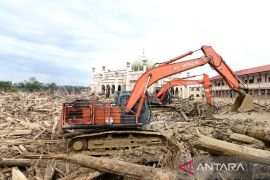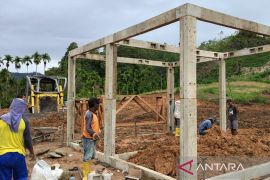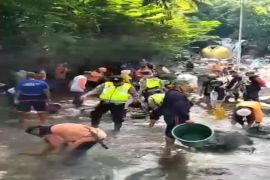The 2022 HKB itself was concentrated in four districts -- Sleman in the Yogyakarta Special Region (DIY) and Boyolali, Klaten, and Magelang in Central Java -- around Mount Merapi. HKB has been commemorated on April 26 every year since 2017.
Head of the National Disaster Mitigation Agency (BNPB), Lieutenant General Suharyanto, during the 2022 HKB activity stated that disaster mitigation readiness in Indonesia had increased in saving the lives of more people.
However, the human evacuation process is often hindered since farmers refuse to be evacuated if they are not allowed to bring their livestock as well.
This phenomenon can increase the risk of casualties and economic losses. The government needs to develop a special strategy to overcome the problem.
The BNPB recorded 2,800 cattle deaths during the 2010 eruption of Mount Merapi, with 332 human fatalities.
Some 12.4 percent of the total economic losses of Rp4.23 trillion had been borne by Small and Medium Enterprises (SMEs), including those in agriculture and animal husbandry.
The BNPB recorded at least 156 volcanic eruptions across Indonesia during the 2010-2020 period, or an average of 15 eruptions a year.
Hence, Suharyanto affirmed that the government had integrated the livestock evacuation as a new and important element in the disaster mitigation efforts, especially in volcanic areas.
Livestock evacuation is closely related to human rescue efforts since they are a valuable life asset for people living in disaster-prone areas. Preparing a livestock evacuation route, in particular, can reduce casualties and economic losses.
Related news: Bali's Tanjung Benoa can be tsunami-resilience model: official
Handling guide
Director-General of Livestock and Animal Health of the Ministry of Agriculture, Nasrullah, stated that his side supported efforts to integrate livestock evacuation in disaster mitigation.
His side is also aware that Indonesia has a high disaster risk related to volcano eruptions.
This is related to more than 1.2 million people in Indonesia living around volcanic areas and making a living in agriculture and animal husbandry, especially small-scale family farmers.
To this end, Nasrullah emphasized that attention should also be given to livestock and their handling during disasters.
Currently, the Ministry of Agriculture is working with BNPB and local governments to prepare guidelines for handling livestock during volcanic disasters, which include arrangements for livestock evacuation and contingency plans.
The guidelines for handling livestock evacuation are expected to be able to complete the evacuation guidelines of humans, so the community can be safe during a disaster, both for residents and their livestock, as the main source of livelihood for families in rural areas.
This livestock evacuation guideline aims to reduce the risk of death and injury to livestock due to volcanic disasters. The guidelines include not only transportation to move livestock but also the need for livestock shelters that are able to meet livestock needs, such as water, feed, and cage sanitation.
Related news: 2,112 government buildings insured: Finance Ministry
Evacuation guide
Director of Veterinary Public Health at the Ministry of Agriculture, Syamsul Ma'arif, stated that animal welfare rules should be followed during the process of evacuating livestock to ensure that the evacuated livestock can safely arrive at the shelter.
Hence, guidance farmers are also required during the evacuation process. A standard operating procedure (SOP) for Livestock Evacuation is required as a guide for officers and farmers in the field for facilitating a proper evacuation process.
Meanwhile, Head of Representative of the United Nations Food and Agriculture Agency (FAO) in Indonesia and Timor Leste, Rajendra Aryal, stated that his side upheld the same commitment on this matter.
He affirmed that the FAO is working closely with the BNPB and Ministry of Agriculture to protect farmers from losses caused by the volcanic disaster.
The FAO is ready to provide various forms of technical support required according to the Sendai Framework guidelines. The Sendai Framework is a global guide to reduce disaster risk in order to conduct studies, develop guidelines for handling livestock, including livestock evacuation, capacity building, and response plans that result in current evacuation simulations.
Related news: GPDRR delegates study Balinese local wisdom on disaster mitigation
World’s Example
The FAO believes that Indonesia’s Presidency in the G20 and the country’s role, as the host of the 7th Session of the Global Platform for Disaster Risk Reduction (GPDRR) in Bali, could become an example for the world regarding disaster mitigation efforts.
With its geographical location between the disaster-prone “ring of fire” and its large population, Indonesia’s experience in handling disasters can serve as a practical example for the world.
Since 2006, the FAO, with funding support from the United States Agency for International Development (USAID), has been working with various ministries and agencies to increase Indonesia’s capacity to prevent and respond to disasters, both natural and non-natural disasters, such as disease outbreaks, which can disrupt public health and stability of the agricultural and food chains that lead to economic losses.
Disaster risk nowadays not only focus on reducing human casualties but also protect livestock as an inseparable component of human life, especially in disaster-prone areas.
The result of the 2022 HKB is expected to be able to integrate livestock evacuation as a new and important element in disaster mitigation efforts.
Related news: Ministry urges tourism actors to enhance disaster mitigation efforts
Related news: Ministry seeks stronger global cooperation on disaster mitigation
Editor: Fardah Assegaf
Copyright © ANTARA 2022











